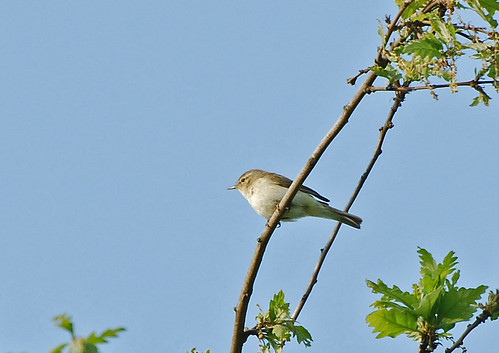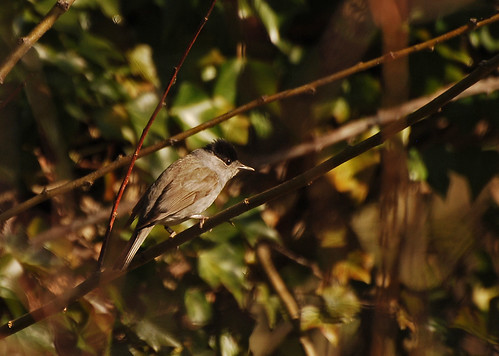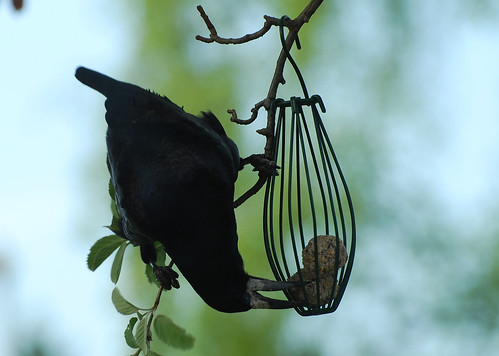Our migrant warblers were all back from Africa and nesting by the beginning of June. There are four species which normally frequent my local countryside, the blackcap (Sylvia atricapilla, Dansk: munk), chiffchaff (Phylloscopus collybita, Dansk: gransanger), willow warbler (Phylloscopus trochilus, Dansk: løvsanger) and the whitethroat (Sylvia communis, Dansk: tornsanger).
The blackcap have been conspicuous by their absence this summer. The central European winter population, of which a pair took up residence in the garden last winter, disappeared in the spring and that was the last time I saw one. Chiffchaff were, as always, the first winter visitor I noticed returning because of their characteristic song calling out from the trees. There are several other birds singing in the background here but the call of the chiffchaff is clear above the others, and it’s easy to see where it gets its name from.
 Chiffchaff male declaring his availability in early spring
Chiffchaff male declaring his availability in early spring
It’s now at the start of September and I haven’t seen a chiffchaff for a while, but through the summer I regularly saw willow warblers which were nesting in a bramble thicket that I passed when I was out walking the dog. Willow warblers are very easy to mistake for chiffchaff by sight but willow warbler song is quite different.
 Willow warbler parent with a beak full of insects heading for the nest
Willow warbler parent with a beak full of insects heading for the nest
The song isn’t the only diagnostic differentiator between these two species, there are a couple of others but they are more subtle. The most noticeable is the colour of the legs, chiffchaff have dark, almost black, legs and the willow warblers are red brown. Differences in plumage of the willow warbler are the brighter stripe over the eye (the ‘supercilium‘), a more promounced dark eyestripe and the patch under the eye (the ‘ear covert’) is olive grey with a pale patch immediately below the eye, compared to the more uniform dark grey colour of the chiffchaff. So if you get a good look through binoculars it’s not too difficult to tell them apart, but the song is the easiest way.
 Another foray to collect flies for the chicks
Another foray to collect flies for the chicks
 Pausing to check up on me before heading into the nest
Pausing to check up on me before heading into the nest
For a couple of weeks there was a spot in the field where I could stand close to the nest and watch the comings and goings of the adult willow warblers bringing food for the youngsters, and they seemed cautious but otherwise content for me to be there if I stood still.
 Whitethroat male – my best ever bird portrait!
Whitethroat male – my best ever bird portrait!
My favourite warbler is the whitethroat. They are easy to tell at a distance, even without optical assistance, and this is my favourite picture of one. The male whitethroat has a jingly jangly song and when he’s advertising for ladies he perches on top of a bush and flies repeatedly in a jerky motion straight up and then flutters back down to the same spot.
And while I was busy photographing the warblers I was being serenaded night after night by this chap:
 A male songthrush (Turdus philomelos, Dansk: sangdrossel) filling the meadow with song
A male songthrush (Turdus philomelos, Dansk: sangdrossel) filling the meadow with song
A tad incongruous in a post about warblers, I grant you, but he was there all the time and his songwas magnificent! As with the chiffchaff there are several other birds calling too, but the thrush is easily distinguishable from the noise. This is the first time I’ve posted a link to my own (amateurish!) sound recording, but I think it’s OK. Let me know what you think.

































































